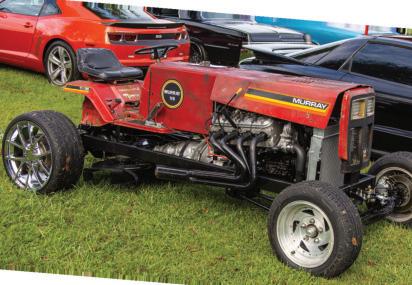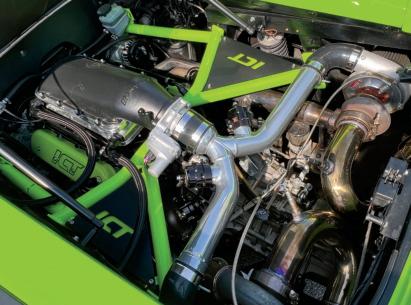
5 minute read
A LEGACY PROJECT
Gary Veeder’s 1966 Nova is a triumph of detail and high-performance understatement.
STEVE TURNER RENZ DIMAANDAL
Advertisement
A Legacy Project
From an early age, Gary Veeder knew he loved cars. His father, Ozzie, loved Chevys. He invested time and money buying used Corvettes and working on them. That passion for hot rodding took hold in the youngster and shaped the rest of his life.
“I always tinkered with my dad. He could never afford to buy new ones, but he always bought Corvettes to work on and fix up,” Gary explained. “He inspired me to get into the body shop business, which I was in for 45 years, retiring last year.”
Not only did Gary carry on his father’s gearhead tradition, but he took it a huge step forward. Upgrading those Corvettes with his father also inspired Gary to take that attention to detail into his business. He opened his body shop, Veeder’s Collision Center, in Watertown, South Dakota, and thrived for decades because of the fastidiousness he learned from his father’s projects.
Left: This neglected 1964 Nova was given a second chance at life.
Right: Everything you need to know about the history of the Chevy Nova.
A Legacy Project
“I have loved cars all my life. Restoration and working on cars is really the only hobby I have tried that I am truly passionate about,” Gary stated. “Seeing something old and making it nice brings me great satisfaction.”
There is a saying about the plumber always having leaky pipes, which implies that the customer work usually takes precedence over personal projects. Alas, this is just as true of a body shop. Veeder’s focused on collision work, so a one-off build became an afterhours project. Drawn to the muscular lines of the 1966 Chevrolet Nova, he spotted one at a car show, and after more than two years of pursuit, acquired that car for just $3,500.
“After eight years, my dad’s dream was to restore and modify the car to a semi-Pro Street,” Gary’s son Bryan explained. “Mom had reservations, wanting him to leave it stock. It was a 1966 SS—a six-cylinder, automatic car. He decided to restore it, and wanted it to be stock appearing, especially on the inside.”
Having pursued a career in the body shop business and growing up under another automotive perfectionist, Gary wasn’t going to bring this car back as a basic build. He was ready to go supernova on the car and create the machine he had always dreamed of driving.
“He started the restoration in 2015, but he wanted the car done ‘his way,’ so he took his time customizing and perfecting this build—6 ½ years to be exact,” Bryan explained. “His family wasn’t sure if the Nova would ever be done.”
Being a perfectionist takes time, especially when the work takes place after a long day at the shop, so it was sure to be a lengthy process. Part of what extended the process was Gary’s desire to add some unique elements that would stand out without deterring from its stock-appearing style.
“The original 1966 had a windshield cowl that could not be removed. They were welded in from the factory,” Bryan said. “From the very beginning of the project, he studied how he could remove it, because otherwise you could never get down in there to paint.”
This is one small example of the level of detail in this Nova, but Gary had to make it work so that the paint would look just right and the car would retain its factory lines, even on something as easily overlooked as the cowl.

“The removable cowl is something that I have never seen done, but I wanted to fabricate a way to remove it so I could get down in there to completely paint it with base and clear and make it nicer,” Gary added. “It was quite a task to get it to fit and make it look finished and stock-appearing. You know a lot of people smooth that over. It’s a cheap way out, but I think that vent looks nice in there.”
Gary pointed out more unique changes. “The ashtray was moved over to make space for the gauge panel. We moved it over to accommodate the delete panel, and then you see that the gauge panel underneath it all lines up. If you look at a stock car, the ashtray is right in the way, so we moved it over about two or three inches so it looks proportional.”
Taking the affordable, easy path wasn’t in the cards for this project. It began for just a few thousand
A Legacy Project
dollars but grew into a six-figure build—and that’s without factoring in the hours of work by Gary and his employees at Veeder’s Collision Center, not to mention the consultation from Doug Engels, who was there for advice on the build.
“I did not want a 2-inch cowl hood on the car, but I had to make room for the 1-inch nitrous plate to fit,” Gary explained. “So I customized the hood with an inset to accommodate the nitrous ring while keeping the top of the hood smooth, like stock.”
Under the hood is a small-block Chevy, a 427-inch engine constructed by Shafiroff Racing Engines, based on a Motown aluminum block and fortified with Eagle 4340 H-beam connecting rods. Breathing through a Motown intake and a Quick Fuel Technology carburetor, it wears CNC-ported AFR aluminum cylinder heads that are completed by PAC Racing valvesprings and Ultra Solid Mag roller rockers that work with a Comp roller camshaft and Comp lifters to actuate 2.08/1.60 valves. Fitted with an ATI Super Damper and Billet Pro Series pulleys, the small-block is cooled by a CSR electric water pump and a pair of electric fans. Fed by a Holley electric fuel pump tamed by a MagnaFuel four-port regulator, a Quick Fuel 850 carburetor supplies the air and fuel lit by an MSD 6AL ignition. It exhales through custom stainless steel headers and a Kriscraft custom stainless steel exhaust system. With a whiff of nitrous from an NX MainLine kit, it generates 564 horsepower at 6,200 rpm and 469.8 lb-ft at 6,200 rpm.
Gary manages that power with a Tremec five-speed transmission mated with a Centerforce dual-friction clutch inside a Quick Time scattershield. As he bangs through the gears, the thrust travels via a chromemoly driveshaft through a Ford 9-inch filled with 4.88 gears, and a custom four-link rear suspension plants the grunt.
Looking mostly period correct, with stock seats reupholstered by Carol’s Upholstery in Watertown, South Dakota, the interior benefits from Auto Meter gauges mounted in the stock dash. Randy Gribble wired up the car with a Ron Francis kit, and Gary modified the dash so that the trick switch panel would line up with that sleek billet radio-delete panel from Tooling Solutions Worldwide of Watertown, South Dakota. With wide rubber out back, the Nova needed mini tubs, but Gary was determined to retain a stock look inside and out. As such, he built a custom rear seat to work with the tubs that makes it look like everything was meant to be. Gary and the team at Veeder’s Collision Center worked hard to get the body lines just right on his Nova. “It takes a team to get it right,” Gary said. They never looked so good back in ’66, nor did the car come equipped with those sleek, billet LED taillights. Likewise, the glass is fresh, and the stainless steel bits are polished.

“It puts a smile on my face and gives me a sense of satisfaction every time I drive it. The sound of its rumble is perfect, and it drives like a rocket,” he said. Though he doesn’t drive it too aggressively these days, Gary plans to keep the car and enjoy it. After investing so much into doing the car his way, and when the result is a Nova like this one, who could blame him?











